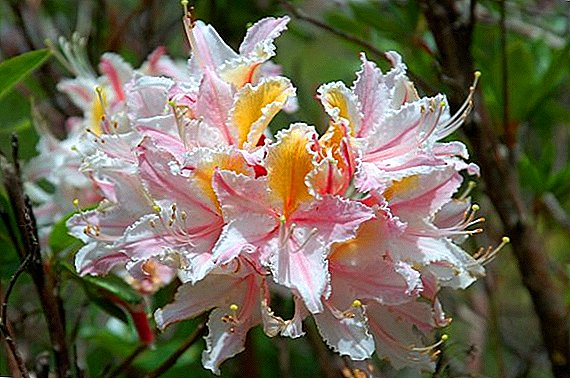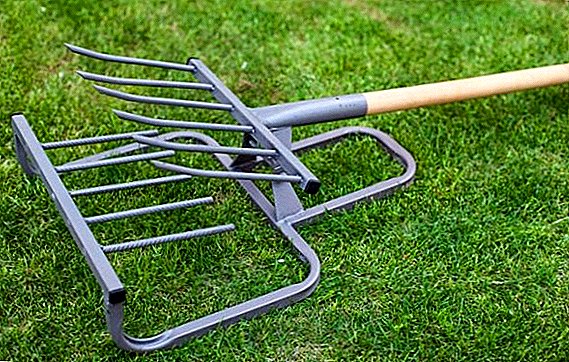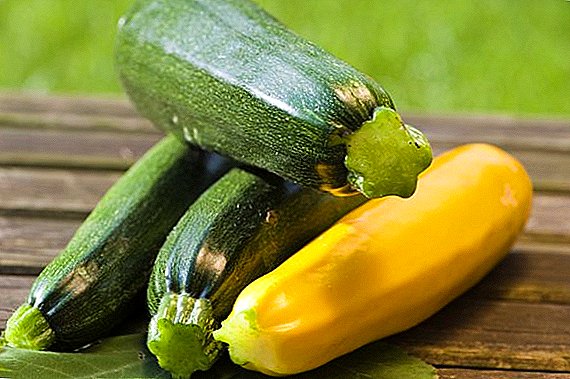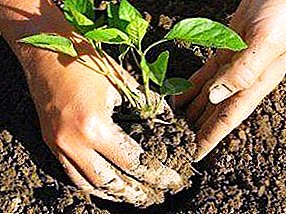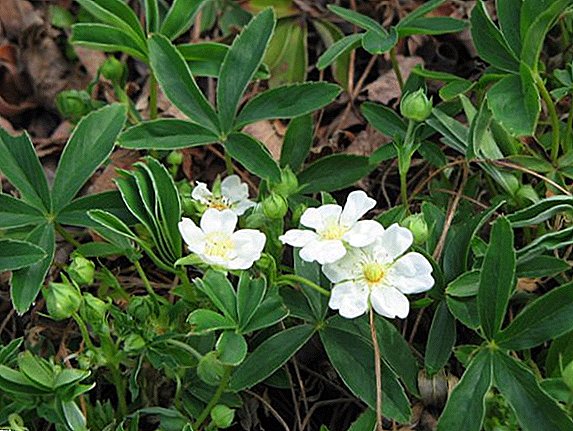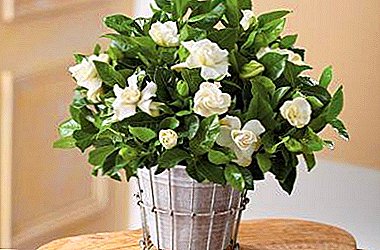
Jasmine gardenia is able to decorate any home. It is fragrant with a light delicate jasmine scent and blooms with white flowers with a wax structure.
If you follow the rules of cultivation, the plant will be healthy and durable. This beauty comes from subtropics, it grows in nature in Japan, China, South Africa. Create conditions close to natural, perhaps, of course, only in the greenhouse, but at home you can also provide gardenia with ample care, allowing you to admire the beauty of this plant.
Further in article we will tell, when the jasmine gardenia blossoms and how to transplant a flower.
Botanical characteristics and history of origin
The history of jasmine gardenia (Gardenia jasminoides) began in the XIII century. It was first described by Alexander Garden - a botanist from America. It was in his honor that the plant was named. Jasmine gardenia flower growers nicknamed Japanese beauty. She hails from India, China and subtropical African forests. In the middle of the XVIII century, the plant appeared in Europe, where they began to form its crown.
Description
The plant develops in a bush-like manner, and in open ground it can reach a height of 2 m. Under room conditions, the bush grows by about 50 cm.
Jasmine Gardenia Leaves:
- glossy;
- dark green color;
- oval with pointed ends (up to 10 cm long).
White terry flowers reach a diameter of 7-10 cm. They exude a pleasant delicate scent of jasmine.
A photo
Here you can see photos of jasmine gardenia:




Landing
In order for the jasmine gardenia to successfully grow and blossom, you need to use an acidic soil and a pot, which should be 1.5-2 cm larger than the root system of the plant. It is also important to comply with all the conditions of care.
Priming
Jasmine gardenia loves acidic soil, and in alkaline and neutral soils it almost does not bloom. Soil for her, you can buy ready-made, for example, suitable soil for azaleas. The finished mixture is made on the basis of coniferous-peat and heather land.
How to care in the home?
Jasmine gardenia - capricious flowerwhich needs careful and painstaking care. With proper care, it bestows fragrant and lush flowering for several months.
Lighting and location
Jasmine gardenia does not tolerate direct sunlight. In its natural habitat, it usually grows under trees. When exposed to direct sunlight, the leaves burn. At home, the plant is better to put on a pallet by the window of the west or east side. At the same time the place in the room should be with diffused light. In winter, you need to provide illumination with a fluorescent or LED lamp.
Important! Jasmine gardenia does not like drastic changes, so often it is not necessary to rearrange it.
Temperature
It is necessary to comply with the temperature regime, as the plant feels comfortable at a temperature of + 22 ° C. In the daytime, it can be increased to + 20 ° С, and at night it can be lowered to + 16 ° С.
Mass formation of buds occurs at a temperature of + 16 ° C ... + 18 ° C, but at higher rates, the plant will direct all forces to the growth of new branches. Supercooling of roots and drafts is unacceptable. Under the pot you can put foam - it will help protect the roots from freezing in winter.
Air humidity
Jasmine gardenia is a tropical plantwhich needs high humidity. For this reason, it is better to put it on a tray with water and wet clay. But you need to make sure that the roots do not get a lot of water. The plant can be sprayed, in the warm season - up to three times. Also allowed to arrange jasmine gardenia warm shower, but making sure that the water does not fall on the flowers.
It is not the plant that is sprayed, but the air around it, since water droplets on the flowers and leaves strongly spoil the decorative appearance.
Watering
Watering gardenia must be above boiled water at room temperature. After 20 minutes, drain the water from the pan. In winter, watering is reduced, but the soil should not be dry. From mid-spring to early autumn, it is necessary to maintain soil moisture, while avoiding dampness.
Land
 The soil for jasmine gardenia can be prepared independently. It is necessary to take in equal proportions:
The soil for jasmine gardenia can be prepared independently. It is necessary to take in equal proportions:
- coniferous land;
- coarse sand;
- sod land;
- high peat;
- deciduous land.
It is important to maintain the acidity of the soil. This can be done by adding a few drops of lemon to the water to water, or using sphagnum, manure, and oak leaf compost.
Fertilizers
Jasmine gardenia feed in the autumn and spring. This should be done twice a month. It is suitable mineral and organic fertilizers, complex means of liquid consistency for flowering plants or azaleas. Once a week it is possible to perform foliar nutrition, sprinkling it with mineral fertilizers.
Attention! The composition of the fertilizer should not include calcium, as the Japanese beauty from it slows growth and does not bloom.
Active period
Jasmine-like gardenia begins its active growth in early spring, and in winter it slows down. Thanks to the trimming procedure, it is possible to significantly stimulate its growth.
Care after purchase
After purchase, the plant is not recommended to disturb. He needs to adapt after stress due to transportation and change of location. Sometimes on arrival home gardenia can throw buds. This is a reaction to the move. Adaptation period lasts 2-3 weeksafter which the flower can be transplanted, but not during flowering.
Pruning
In order to form a lush beautiful bush and new buds after flowering, the jasmine-like gardenia needs to be trimmed. The form is attached by pinching the top of the shoots. After the plant has faded, it is necessary to remove the curves and weak shoots, and cut off the strong ones by 1/3. With the help of pinching the top of the crown and cutting the lower branches you can make the bush miniature. Usually an adult plant is pinched once a year.
Blooming Jasmine Beauty
Flowering jasmine gardenia begins in March and lasts until September. First, the plant is prepared for this process, then in April-March buds appear. During the flowering period you can not replant, move or move the flower. In the opposite case, the plant will drop flowers. They bloom in turn, so flowering often lasts two months. Blossoming flower kept on the bush for about 4 days. After it has faded, it needs to be cut off so that new flowers begin to form.
Transfer
 Before you begin to transplant the plant you need to prepare the substrate and a good pot. Transplantation is performed about once every 3 years - it all depends on the growth of the root system. Soil renewal should be done in early spring and only after flowering. Jasmine gardenia does not tolerate the transplant, so For faster adaptation and recovery, the following handling method is recommended:
Before you begin to transplant the plant you need to prepare the substrate and a good pot. Transplantation is performed about once every 3 years - it all depends on the growth of the root system. Soil renewal should be done in early spring and only after flowering. Jasmine gardenia does not tolerate the transplant, so For faster adaptation and recovery, the following handling method is recommended:
- The soil is plentifully watered and taken out of the pot plant with a clod of earth.
- At the bottom of the new pot lay out a thick layer of drainage.
- Gardenia is placed with the earth in a pot and sprinkled with soil.
Transplantation of jasmine gardenia:
Lifespan
Wild jasmine gardenia lives in its natural habitat for 15-20 years. At home, this period is reduced to 10 years. If the care and the room do not meet the requirements of this rather capricious flower, then the life expectancy will be no more than a year. Young plants grow and bloom well, so many recommend not keeping them for more than 4 years, but growing several young gardenias at once.
How to multiply?
Jasmine gardenia bred in two ways - seed and vegetative.
Growing from seed
Reproduction by seeds is carried out from the end of February to the middle of March. In this case, you need to use the purchased seed or independently collect it. The main thing here is to be fresh.
Before sowing, the seeds should be soaked for a day, after which they should be planted in the ground. It should be at room temperature. From the sprayer, the soil is sprayed from above with water. The container is placed in a mini greenhouse, where the temperature is at least + 25 ° C. After 30 days you can see the first shoots. A flower grown from seed blooms two years later.
Video on how to grow gardenia with seeds:
Reproduction by cuttings
Vegetative method involves the preliminary pruning of a plant:
- Leaves are removed from strong and healthy shoots (length 10 cm), leaving 2-3 pieces on top.
- The slice is treated with root powder, then placed in a sand-peat mixture.
- Then it is closed with transparent polyethylene, creating greenhouse conditions. Using bottom heating with a lamp, you can speed up the formation of roots.
- The cuttings are regularly watered and sprayed with water, and the greenhouse is aired.
After a month, rooting of seedlings occurs, which are transplanted into a pot.
Video on the reproduction of gardenia jasmine cuttings:
Diseases and pests
 If the jasmine-like gardenia does not bloom, languishes and does not grow, then pests have appeared. It is mainly attacked:
If the jasmine-like gardenia does not bloom, languishes and does not grow, then pests have appeared. It is mainly attacked:
- whiteflies;
- scythes;
- thrips;
- mealybug;
- spider mite;
- aphids.
When the first signs appear, the plant should be sprayed with an odorless insecticidal solution - Decis, Aktelic, Fitoverm. For greater effect, you need to repeat the procedure after 5 days. Infected leaves are removed, and gardenia is isolated from other flowers.
Blacken and fall leaves
If the lower leaflets are damaged first, it signals a problem with the roots, a nutritional deficiency, or flooding. The reason may be excessive soil compaction, lack of air access. We must pay attention to the holes for drainage, they can clog. In this case, cleansing will help. If the leaves are blackened from above, the plant may be affected by insects.
Yellow leaves
Yellowing of the leaves can be provoked by damage to the roots and improperly chosen watering system. Both deficiency and excess moisture adversely affect the root system. As a result, yellow leaves appear, sometimes with brown spots. Another reason may be a low temperature in the room and the wrong composition of the soil.
Why does not bloom?
There are several common reasons why gardenias do not bloom:
- alkaline soil;
- lack of light;
- dry air;
- wrong temperature conditions;
- deficiency of nutrients, especially phosphorus, magnesium, potassium and iron.
How to save a houseplant?
In order to save the plant you need to put it on a bright place, avoiding bright sunlight. It is necessary to use only boiled and separated water for irrigation. The pot must be put on a tray with water for additional feeding. Flower necessarily fertilized.
Proper care of a jasmine-shaped garden requires a lot of attention and patience. But as a result, Japanese beauty will thank light jasmine aroma and delicate white flowers.





